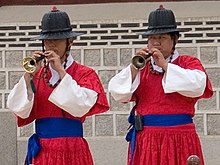Our website is made possible by displaying online advertisements to our visitors.
Please consider supporting us by disabling your ad blocker.
Taepyeongso
This article should specify the language of its non-English content, using {{lang}}, {{transliteration}} for transliterated languages, and {{IPA}} for phonetic transcriptions, with an appropriate ISO 639 code. Wikipedia's multilingual support templates may also be used. (May 2019) |
| Taepyeongso | |
 Taepyeongso players playing in front of the Gyeongbokgung | |
| Korean name | |
|---|---|
| Hangul | 태평소 |
| Hanja | |
| Revised Romanization | taepyeongso |
| McCune–Reischauer | t'aep'yŏngso |

The taepyeongso (Korean: 태평소; lit. big peace wind instrument), also called hojok, hojeok 호적 號笛/胡笛, nallari, or saenap, 嗩吶, is a Korean double reed wind instrument in the shawm or oboe family. It is possibly descended from the Persian sorna and is closely related to the Chinese suona. It has a conical wooden body made from yuja (citron), daechu (jujube), or yellow mulberry wood, with a metal mouthpiece and cup-shaped metal bell. It originated during the Goryeo period (918–1392).
The loud and piercing sound it produces has kept it confined mostly to Korean folk music (especially "farmer's band music") and to marching bands, the latter performed for royalty in the genre known as daechwita. It is, however, also used sparingly in other genres, including Confucian, Buddhist and Shamanist ritual musics, neo-traditional/fusion music and kpop, included in works such as "Lalalay" by Sunmi (2019).
The volume is large and the pitch is high, making it suitable for playing outdoors.[1]
Taepyeongso was originally an instrument used in military camps, but after the late Joseon Dynasty, its playing area expanded to include nongak and Buddhist music. In recent years, it is also used as a solo instrument and in original music. Taepyeongso is the only instrument that plays a melody among the instruments used in military music, agricultural music, and Buddhist music.[2]
Previous Page Next Page


